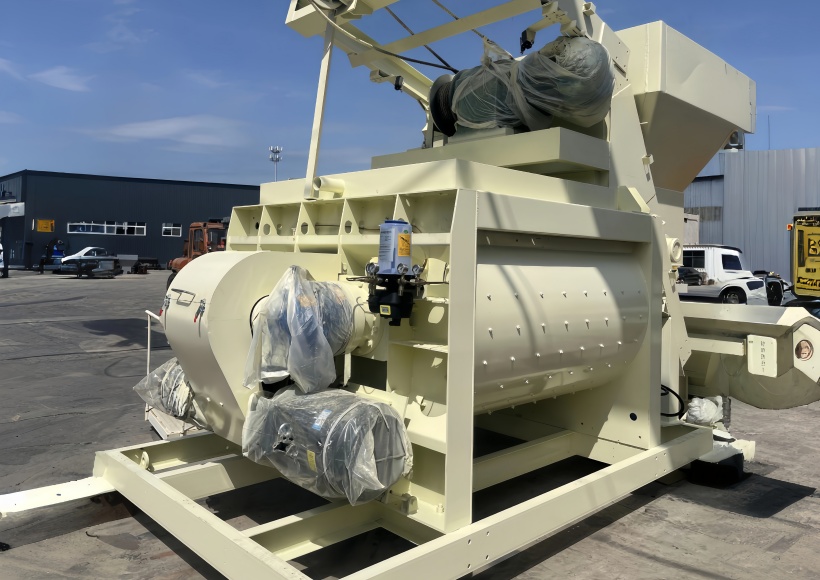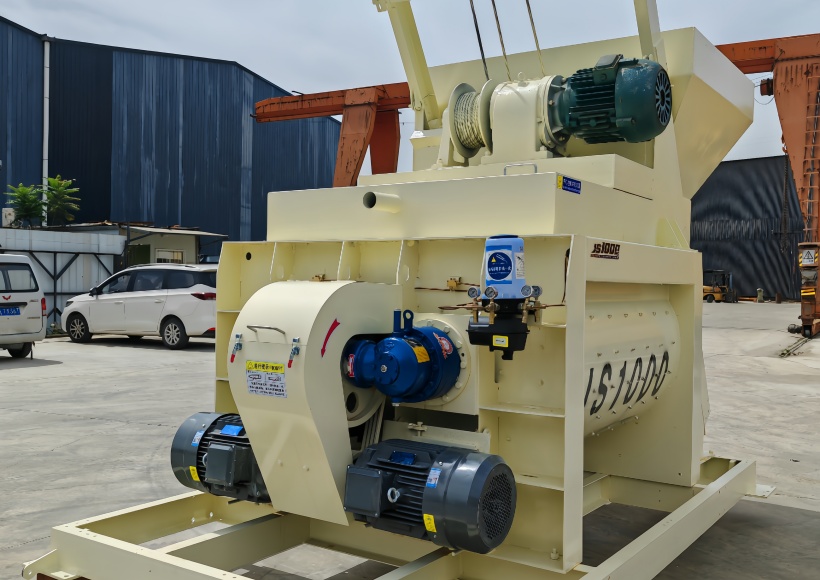The JS1000 mixer is a common model in concrete production equipment. The choice of drive option directly impacts its performance, service life, and production efficiency. This article will deeply analyze the advantages and disadvantages of single reducer drive, dual cycloid reducer drive, and dual planetary reducer drive to help you make an informed choice.
Drive Option Overview: Understanding the Core Differences of the JS1000 Mixer
The drive system of the JS1000 mixer is its core component, responsible for transmitting the motor power to the mixing unit. Different drive options vary significantly in structural design, durability, and applicable scenarios, directly affecting the equipment's performance in concrete production.

1. Single Reducer Drive (Basic Economy Model)
Structure and Operating Principle
The single reducer drive features a simplified design consisting of a ZQ gear reducer and a 37kW motor. The entire mixing load is handled entirely by a single reducer. This structure eliminates the need for a complex transmission chain, reducing manufacturing costs.
Performance characteristics analysis
- Cost advantage: low initial investment, high degree of standardization of parts
- Easy maintenance: simple structure, easy daily maintenance
- Load limit: single point bears all loads, long-term high-intensity operation can easily lead to overheating and wear
Applicable scenario evaluation
Single reducer transmission is most suitable for application environments with low production intensity and limited budget, such as:
- Small construction projects
- Intermittent production needs
- Short-term engineering applications
- Backup equipment or low-frequency use scenarios
2. Dual reducer transmission (two technical routes)
Dual reducer transmission improves system reliability by sharing the load, and is mainly divided into two technical routes:
(1) Double cycloid pinwheel reducer (gear direct drive)
Structural features
Two cycloid pinwheel reducers work in parallel, and the power transmission adopts pure gear transmission, without the need for an intermediate buffer link.
Advantages and limitations
- Transmission efficiency: Direct gear meshing, low energy loss, high transmission efficiency
- Precision control: Stable output, good mixing consistency
- Shock resistance: Lack of buffer mechanism, sudden overload directly acts on the gear system
- Repair cost: Gear damage usually requires replacement of the entire reducer, which is expensive
Applicable working conditions
It is recommended to be used only in production environments with stable loads, uniform raw materials, and rare overload conditions, such as:
- Ready-mixed mortar production
- Lightweight concrete mixing
- Prefabricated component factories with stable working conditions
(2) Double planetary reducer (V-belt drive)
Structural innovation
Combining two planetary reducers with a V-belt drive system, a flexible transmission element is creatively introduced.
Technical advantages
- Overload protection: The V-belt slips when overloaded, effectively buffering the impact load.
- System life: The reducer is protected, significantly extending its overall service life.
- Maintenance efficiency: The cost of replacing the belt is much lower than repairing or replacing the reducer.
- Adaptability: Able to cope with load fluctuations common in concrete production.
Applicable Scenarios
This is an ideal choice for most commercial concrete production applications, particularly for:
- Commercial concrete batching plants
- Large-scale engineering projects
- High-intensity continuous production
- Production environments with high raw material variability.
Comparison of technical parameters of three drive types
Transmission mode | Single reducer | Double cycloid reducer | Double planetary reducer |
structure | 1 reducer | 2 reducer | 2planetary reducers + V-belt |
Overload resistance | Very poor | The reducer is easy to break | Belt slippage |
Maintenance costs | Very high | high | Low |
Applicable Scenarios | Low-intensity production | Stable light load | High-intensity continuous production |
JS1000 Mixer Drive Selection Guide
Budget-Based Selection
- Tight Budget: Single Reducer Drive Offers the Lowest Initial Investment
- Medium Budget: Considering Long-Term Operating Costs, Dual Planetary Reducer Drive is More Economical
- Ample Budget: Directly Choose a Dual Planetary Reducer Drive to Maximize Return on Investment
Production Needs-Based Selection
- Intermittent Production (<4 Hours of Daily Operation): Single Reducer Drive May Meet Requirements
- Stable Production (Known Raw Materials, Constant Formula): Double Cycloidal Pinwheel Reducer Can Be Considered
- High-Intensity Production (>8 Hours of Daily Operation): Dual Planetary Reducer Drive is a Must
- Variable Operating Conditions (High Raw Material Variation): Dual Planetary Reducer Drive Offers the Best Adaptability
Maintenance Capability-Based Decision
- Limited Maintenance Resources: Dual Planetary Reducer Drive Reduces Dependence on Professional Repairs
- Professional Maintenance Team: More Technical Options Available
- Remote Applications: Prioritize Solutions with Ease of On-Site Repair
Professional Advice for Optimizing Equipment Performance
Methods for Improving the Lifespan of JS1000 Mixers
Regardless of the drive system selected, the following measures can significantly extend equipment life:
1. Regular Inspection: Establish a strict daily inspection system.
2. Load Management: Avoid continuous overload operation.
3. Lubrication and Maintenance: Perform lubrication and maintenance according to specifications.
4. Professional Training: Ensure operators understand the characteristics of the equipment.
Drive System Upgrade Considerations
For existing equipment, upgrading from a single reducer to a dual reducer drive system is feasible, but the following should be evaluated:
- Comparison of the upgrade cost with the new equipment investment.
- Whether the equipment structure supports the upgrade.
- The time cost of the production downtime for the upgrade.

Conclusion: Recommended Optimal Drive Solution for JS1000 Mixers
After a comprehensive technical analysis, we have reached the following conclusions regarding the drive system for the JS1000 mixer:
A dual planetary reducer (V-belt drive) is the optimal choice for most applications. Its excellent overload protection, low maintenance costs, and long service life provide reliable support for continuous, high-intensity production. While the initial investment is higher, the total cost of operation is lower over the long term.
Single reducer transmissions are only suitable for special situations with extremely limited budgets and low-intensity use. Users must accept a higher risk of failure and a shorter service life.
Double-cycloid pinwheel reducers perform well under certain stable operating conditions, but their lack of overload protection limits their application range, making them generally not recommended as a first choice.
When selecting a JS1000 mixer, it is crucial to carefully consider your actual production needs, budget constraints, and maintenance capabilities to select the most appropriate transmission method. The right choice not only ensures production efficiency but also significantly reduces long-term operating costs, maximizing your return on investment.
If you require more detailed technical advice or equipment selection recommendations, please contact our professional team. Tongxin Machinery will provide a customized solution tailored to your specific application.